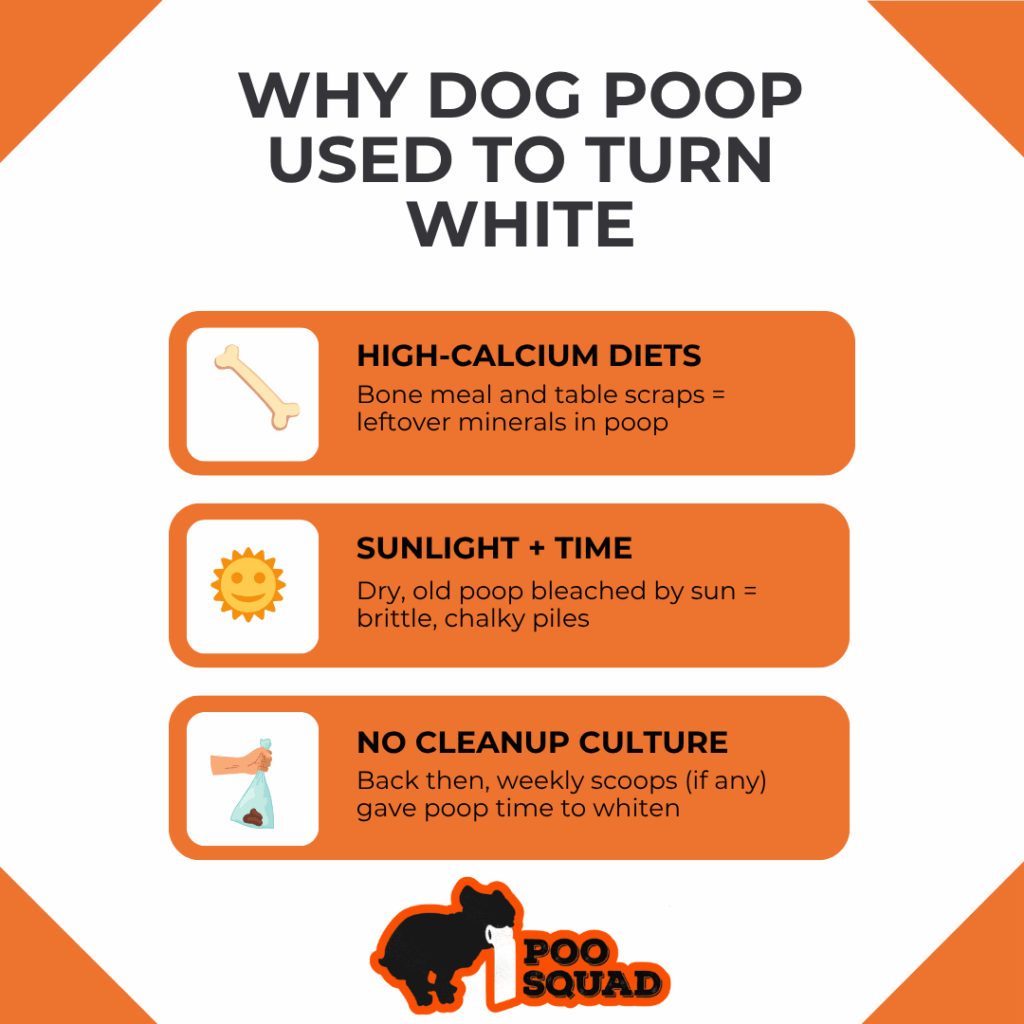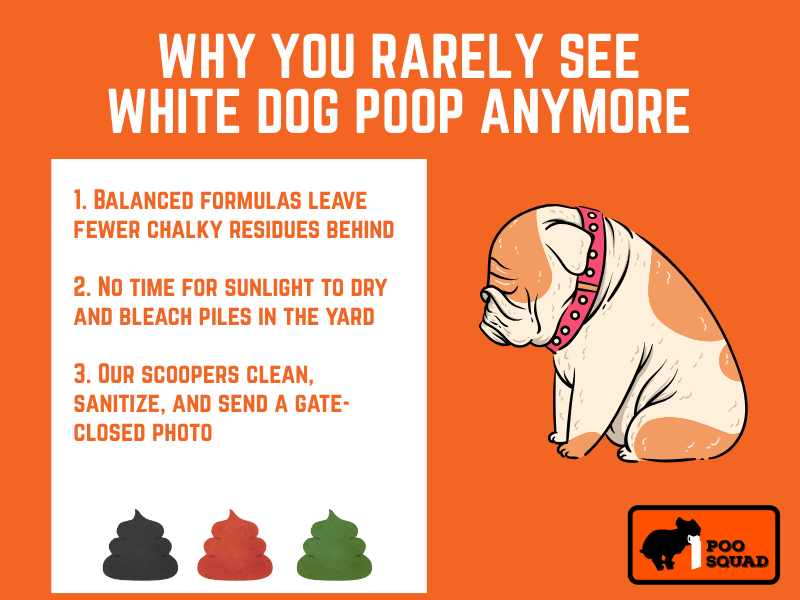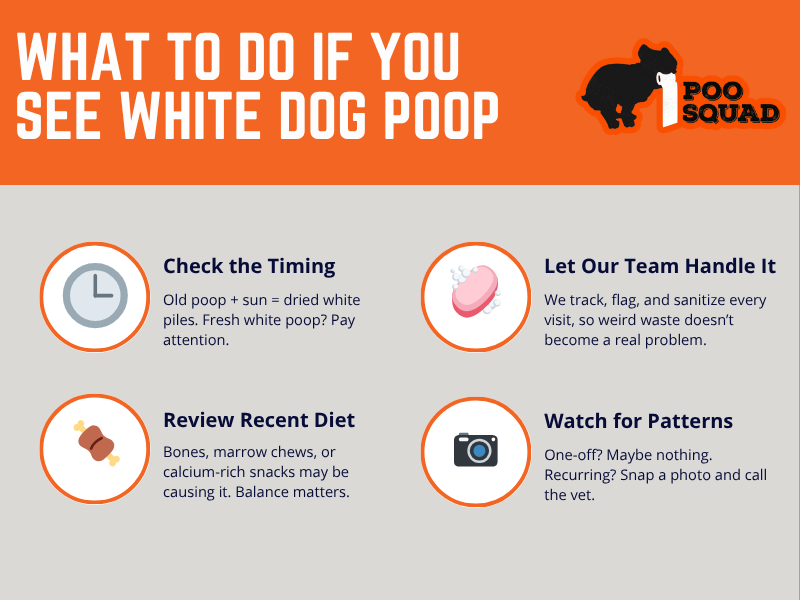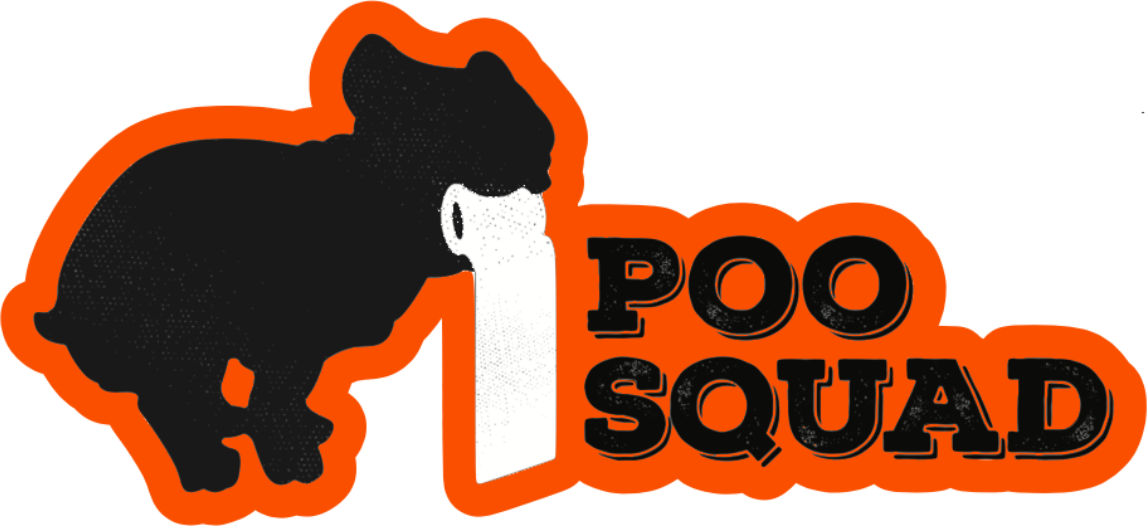Why You Don’t See White Dog Poop Anymore
Dog poop doesn’t turn white anymore because today’s diets contain less bone meal and excess calcium, and yards get cleaned before waste has time to dry out and bleach in the sun. Modern pet nutrition, better digestion, and faster pickup habits have made the chalky piles of the past mostly disappear.

But what looked like harmless “dusty poop” wasn’t just a strange backyard memory. It often pointed to dietary imbalances or poor waste hygiene. Now that it’s gone, that’s a sign of progress, both for your dog’s health and your lawn’s safety.
If you’ve spotted white or pale poop recently and wondered what it means, you’re not alone. Here’s what this guide covers, step by step:
If you’re seeing chalky poop or pale droppings in your yard, this guide gives you the answers, just real insight from a team that sees this stuff every day.
What Made Dog Poop Turn White Back in the Day?
White dog poop was once a common sight, especially in backyards and sidewalks where scooping wasn’t a priority. But that chalky appearance wasn’t magic; it was all about what dogs were eating, and how long the waste sat undisturbed. Here’s what was going on.
High-Calcium, Bone-Heavy Diets
Older commercial dog foods often relied heavily on bone meal as a filler. Dogs also got more raw bones and scraps from the table, especially in homes where leftovers doubled as dinner for the family pet. That calcium-rich diet didn’t digest fully, leaving behind hard, white, chalky waste.
Sunlight and Decomposition
When poop is left in a yard for days, it starts drying out. Moisture evaporates, and any leftover minerals, especially calcium, become more concentrated on the surface. The result? A brittle, bleached pile that flakes apart like sidewalk chalk. These weren’t fresh stools; they were aging relics.
Lack of Cleanup Culture
Back then, routine dog waste pickup wasn’t part of most people’s schedules. Families might’ve sent a kid out once a week with a shovel, if that. Poop had time to break down, bleach, and turn pale, especially in sun-exposed areas. Today, regular dog poop pickup services prevent that from ever happening.
A Bit of Nostalgia, A Lot of Gross
We’ve heard it from customers: “Remember when dog poop used to turn white?” Sure, and it also stuck to your shoes, attracted flies, and wrecked lawns. The disappearance of white poop is a sign of progress, not loss. These days, the only white thing left behind is a freshly sanitized yard.
The Science Behind White Dog Poop
White poop is not random, it’s science. From calcium levels to digestive enzymes, what happens inside your dog has everything to do with what you see in the yard. When you know what’s behind the color change, you’ll start noticing signs of health (or issues) with every scoop.
Calcium, Bones, and Digestion
Excess calcium is the number one reason dog poop used to turn white. When dogs were fed bones, bone meal, or high-calcium fillers, their bodies couldn’t absorb it all. The leftovers passed through as undigested minerals. When that stool dried out, calcium was all that remained, and calcium turned white.
For pet parents feeding a raw diet today, the same thing can happen. If the bone ratio is too high, you’ll still get chalky white poop. It might look clean, but it’s a sign of imbalance. That’s why we always suggest keeping a close eye on stool consistency.
Our poop report card is built for exactly that.
The Role of Bile and Digestive Enzymes
Bile is what gives poop its usual brown color. It’s produced in the liver, stored in the gallbladder, and helps break down fat in the intestines. If bile is not flowing right, due to liver issues, a blocked duct, or poor fat digestion, stool can come out pale or even clay-colored.
This is different from poop that turns white after sitting outside. If your dog’s stool is coming out light-colored from the start, that’s a red flag. We’ve seen it a few times during scooping, and we always flag it in the report. It could point to a bile deficiency or a pancreatic issue.
When White Poop Means a Health Problem
Poop that’s white, dry, and crumbly could mean your dog’s getting too much bone. But if it’s pale, greasy, or light gray from the moment it hits the grass, something internal might be off. If you’re ever in doubt, take a photo and call your vet.
Need help spotting the difference?
We’ve got your back.
Our team is trained to notice what others miss, and we sanitize your yard afterward to make sure nothing harmful is left behind.
Why White Poop Has Disappeared (And What Replaced It)
Dog poop today doesn’t only look different, it behaves differently too. From what your dog eats to how often someone picks up the yard, the conditions that used to create white poop rarely exist anymore. Cleaner diets and cleaner habits have completely changed the picture.

Balanced Nutrition Over Bone Meal
Dog food has come a long way. These days, most commercial brands are built around digestible proteins, healthy fats, and carb-based fillers like rice or sweet potatoes. There’s far less reliance on hard-to-digest animal byproducts like bone meal, which means less calcium residue in your dog’s waste.
With nutrients absorbed more efficiently, there’s simply less mineral “left behind.” And with more pet parents investing in better food, it’s rare to see a pile that looks like it was made from sidewalk chalk.
If you’re curious how diet changes show up over time, we help monitor that. Each visit in our residential pooper scooper service includes a quick stool check. When we see something off, we note it in your dog’s poop report card, a small step that can make a big difference in catching health issues early.
Poop Doesn’t Sit Around Anymore
Big reason white poop has vanished: it doesn’t have time to turn white anymore. Back in the day, poop stayed in yards for days or weeks. Now? Between poop bags, scoopers, and weekly service, it gets picked up fast.
We show up in bright orange trucks with sanitized tools, clean it up, and take it away, long before the sun has a chance to dry it out or bleach it. You get a closed-gate photo, a fresh-smelling yard, and no prehistoric fossils under your kids’ swingset.
Not to mention, our sanitation service makes sure whatever lingers, bacteria, odor, germs, is handled before your dog’s paws can track it back inside.
The Forgotten Downsides of White Dog Poop
Sure, people joke about “missing” white dog poop, but trust us, there’s nothing to miss. That chalky stuff was more than an eyesore. It came with real downsides, from lawn damage to misleading assumptions about your dog’s health. Here’s why we’re glad it’s gone.
Chalky Doesn’t Mean Clean
A white pile might look “clean,” but it’s often too dry. That usually means your dog’s diet has too much calcium or bone. If it crumbles when you try to scoop it, that’s not a badge of honor; it’s a red flag. Dogs need balance, not bricks.
Through our pet profile program, we track poop patterns and help flag this kind of thing early. You’ll get a full report and customized feedback if we see chronic white waste in your yard.
Hard Poop Can Hurt
Excessively hard stools can lead to constipation or even cause micro-tears in your dog’s rectum. We’ve heard from more than one customer whose pup was struggling because they were chewing too many bones or getting a raw diet without the right fat-to-bone ratio.
Want to know what a healthy poop should look like? Ask your scooper during your next residential service; we’re more than happy to share what we see.
It Kills Grass (And Stinks Doing It)
Old, dry poop might seem “inert,” but it’s not. It still leaches bacteria and minerals into your soil. That’s how those dead spots happen, especially with high-calcium waste. And if you’re storing it in your trash bin, the smell lingers longer than you think.
We never use customer trash cans. We scoop, sanitize, and leave nothing behind, including the smell. That’s part of our commitment to proper sanitation and deodorizing.
When to Worry About White or Pale Dog Poop
Not all white-looking poop is harmless. Some signs could mean a dietary imbalance, while others might signal that something more serious is going on internally. Knowing the difference helps you act early, and that’s where our team can step in with eyes on the ground, literally.
It Comes Out White, Not Turns White
If poop is coming out of your dog looking white or pale gray, and not turning that way over time, that’s a big distinction. Fresh white stool can mean liver issues, bile duct problems, or an imbalance in your dog’s ability to digest fat properly. It’s rare, but we’ve seen it.
Our scoopers are trained to flag these signs during routine residential pickups. If we notice anything that doesn’t look quite right, we’ll send you a photo and drop a note in your poop report card.
It Looks Greasy or Clay-Colored
That shiny, clay-colored poop? It might look smooth, but it usually means your dog is not absorbing nutrients properly. Greasy texture often points to pancreatic issues or a lack of enzymes. It’s worth a call to the vet, especially if you’ve noticed other changes in appetite or behavior.
It Coincides with New Treats or Diets
We’ve had pet parents reach out after trying a new chew or bone, only to see the next day’s pile turn ghost white. That’s not unusual, especially with marrow bones or mineral-rich treats. But if it keeps happening, it’s time to re-evaluate the ingredient list or get some help from your vet.
Need a second set of eyes on what’s changing in your yard? That’s what we’re here for. Our goal is to keep your dog healthy and your lawn spotless.
Cleaner Poop Means Healthier Dogs
While white poop might spark some backyard nostalgia, its disappearance is actually a good sign. It means your dog is likely eating better, digesting more efficiently, and living in a cleaner environment. And with regular monitoring, we can help make sure it stays that way.
Better Diets, Smarter Feeding
Modern pet food is designed to meet specific nutritional profiles. That means fewer byproducts, better ingredient sourcing, and improved digestibility. When dogs get what they need (and not what they can’t process), their poop reflects it, in texture, color, and consistency.
We help you keep tabs on this with our residential scooping program, which includes optional poop reports for any signs of concern. Because when your dog’s digestion is right, everything else tends to follow.
Waste Is Managed, Not Forgotten
No more week-old piles hiding behind the grill. Between poop bags, daily scooping, and scheduled pro services, waste doesn’t stick around long enough to break down into anything unnatural, including that powdery white fossil look from the old days.
Cleaner yards mean happier dogs, healthier grass, and fewer unwanted surprises for your kids (or your shoes).
Our Tools Stop the Spread
There’s another benefit to cleaner poop: less bacteria spread. We clean and sanitize all our tools between yards, and every technician wears boot covers or sprays down between stops. It’s part of our sanitation promise and something you won’t find with the kid down the block and a grocery bag.
Want extra protection? Add on our deodorizer service for a fresh-smelling lawn that’s not only clean, but it’s safe.
What to Do If You See White Poop Today
Seeing something strange in your yard?
Whether it’s a flash of white or something off in texture or smell, don’t panic, but don’t ignore it either. A closer look at your dog’s waste might tell you more than any app ever could.

Step 1: Check the Timing
If the poop turned white after a few days outside, it’s likely due to sun exposure and a calcium-rich treat. If it was white from the moment it dropped, pay closer attention. That’s usually an internal issue and worth watching.
Step 2: Look at the Diet
Have you added bones, marrow chews, or high-calcium treats recently? That might be your answer. If your dog is raw-fed, consider whether you’re overdoing the bone content. Balance matters, and poop is your most honest feedback loop.
Step 3: Watch for Patterns
One white pile? Probably not a big deal. A few in a row? Take a picture, save it, and reach out to your vet. Or let us keep tabs for you. Our team does this every day, and we’re trained to notice what others overlook.
We’ve had more than one customer say they avoided a vet bill simply because our scooper noticed something early. That’s the power of consistency and trained eyes.
Step 4: Let Us Handle It
If you’re not already signed up, check out our residential pooper scooper service. We don’t only remove the waste, we notice what’s in it, we sanitize what’s under it, and we protect everything around it.
Cleaner poop means a healthier dog. And that’s why the white stuff belongs in the past, not your backyard.
Want to Know What Your Dog’s Poop Says About Their Health?
We don’t guess, we track. Our Pet Profile Program is built for dog parents who care about more than clean yards. When you join, you’ll get:
- A custom QR-coded dog tag for every pup
- Access to their online pet profile
- Real-time poop report cards during cleanups
- Service reminders so you’re never wondering when we’re coming
It’s free for customers, takes two minutes to sign up, and it might be the easiest way to catch small health issues before they become big ones.
Join the Pet Profile Program here, because there’s a story behind every scoop, and we’re here to help you read it.
Questions from Pet Owners (Answered Honestly)
You’d be surprised how often people ask about white dog poop, usually with a mix of curiosity and worry. These aren’t silly questions. They come from real concern and lived experience. So here are some of the most common ones we hear, and what we tell our customers when they ask.
Is my dog sick if his poop turned white?
It depends. If the poop is turning white after sitting in the yard, it’s likely a diet or exposure issue. But if the stool is coming out pale or chalky, that could signal a health problem, anything from bile duct issues to nutrient malabsorption. We flag it immediately when we see it.
Worried about what you’re seeing? We can help you track it with our poop report cards, and make sure your vet gets photos if needed.
Do poop bags trap the color-change process?
Absolutely. Once the waste is bagged, it’s no longer exposed to air or sunlight, which are the key players in drying and bleaching. So modern cleanup habits are one of the biggest reasons you don’t see white poop anymore, and that’s a good thing.
Why do I see it in one dog but not the other?
We’ve seen this before. Some dogs digest calcium better. Others may eat different foods, have different hydration levels, or simply poop in spots that get more sun exposure. If it’s happening consistently, check their diets or ask us to take a look during your next cleanup.
Could it be something in my yard?
One customer once thought runoff from a deck cleaner was bleaching poop. In reality, it was old bones from a marrow treat her dog had been chewing. White poop is rarely caused by external chemicals, it’s usually internal. That said, if anything looks unusual, we will always let you know.
Does white poop mean worms?
Nope. Worms look like grains of rice or spaghetti, not chalky piles. White poop means dry, mineral-rich, or improperly digested food, not parasites. But if you’re still unsure, snap a pic and share it with your vet or our team.
Author: Chief Scooper
Jamie Coones is the founder of Poo Squad. He started the original location in Manhattan, KS in 2017 and has since licensed the brand to another 20 other owners with locations across the country.
